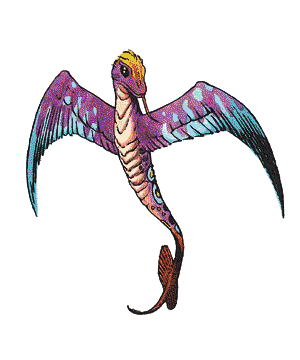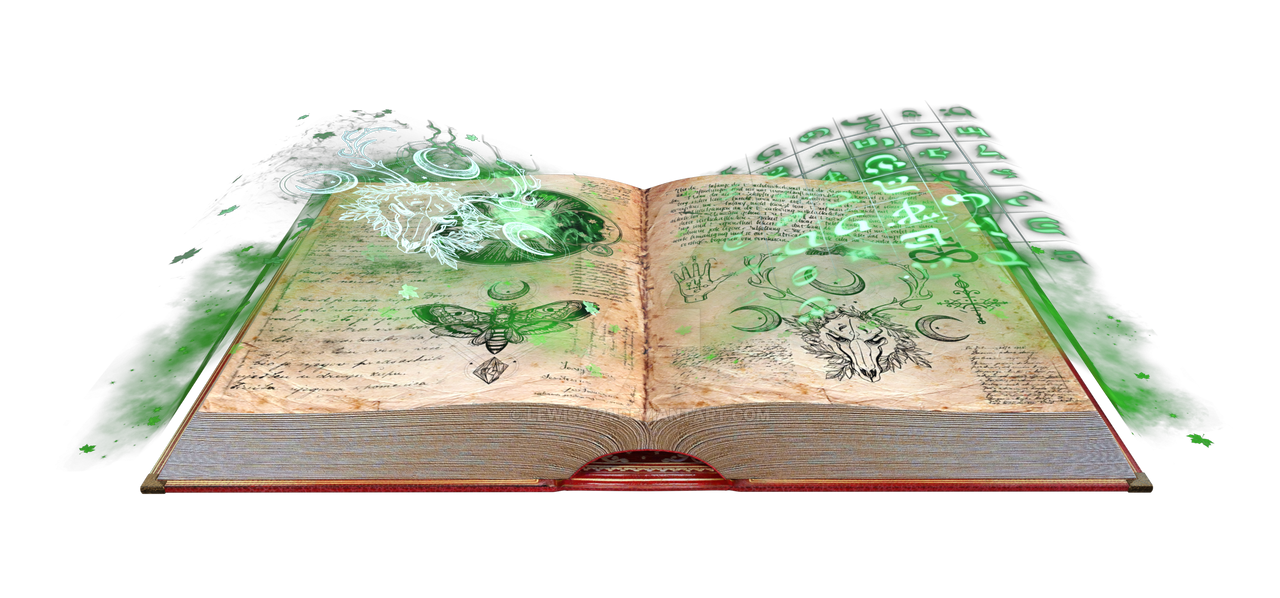Winged Serpent
Kyreshin

Winged Snake by TSR
Kyreshin, also known as winged snakes, winged serpents, and spark snakes, are a rare species of magical snake with a long history of being familiars for witches and wizards who speak parseltongue.
Winged serpents have appeared in myths, legends, and folklore throughout the world, and are often signs of wisdom, plenty, and occult mysteries. At one time, many wizarding scholars, sages and teachers would keep them as pets.
Winged serpents have appeared in myths, legends, and folklore throughout the world, and are often signs of wisdom, plenty, and occult mysteries. At one time, many wizarding scholars, sages and teachers would keep them as pets.
Basic Information
Anatomy
Magizoologists believe that at one time, there were many species of winged serpent throughout the world, as they appear in legends, myth and folklore from civilizations all over the world, but there are currently only one known species.
Winged serpents are herbivourus reptiles approximately one to one and a half meters long. They are sinuous and and have been seen in a variety of jeweltone colors that include blues, greens, reds, and purples. Their scales, like their feathers, are metallic in both appearance and composition, but are incredibly soft, warm and supple.
While they are somewhat cold blooded, their magical nature makes them less susceptible to cold.
Just below their heads and necks, they have a pair of feathered wings with a wingspan measuring approximately three fourths of their body length. These wings, despite their feathers, do not actually contribute to flight, but produce amazing, jewel tone feathers with unique propeties, including being reflective and refractive of light, and appear to have high mineral and metallic content.
Their bodies and wings are incredibly strong - as most snakes are mostly muscle, and they are capable of moving with incredibly speed. Far faster than than any 'natural' snake or bird, but cannot seem to fly long distances.
Their fangs appear to be made of a crystalline structure that is part mineral, part organic.
It has also been observed that a winged serpents wings are extremely delicate, but can, in fact, grow back or regenerate from parts of them even being ripped or cut off, as long as no damage has been done to the root of the wing.
Genetics and Reproduction
Winged snakes mate often and with many partners, mostly through spring and summer. Though rare, some do mate in the early fall, but by the time winter comes around, all mating activity has ceased.
Winged snakes are fertile about a year after hatching, and can produce up to six clutches of eggs a year. A typical clutch of eggs is anywhere between two and six eggs, with an average of half being infertile.
A health winged serpent will carry her eggs for about a month before laying them in a hole in a tree they have carved out using their acid. They will cover this 'nest' with leaves, and pile rocks and fruit inside for their young.
A male winged serpent will remain with the eggs while they incubate and hatch, usually within hours of being laid.
Baby spark snakes are born with the full range of instinctive knowledge and abilities, but will be unable to levitate until they have eaten.
The male will watch and defend the clutch for about two days before leaving their young to survive as part of the flock. While they are capable of levitating and finding their own food, their wings are not fully mature until they are a month old.
Because spark snakes are social creatures and tend to have large flocks, males will often work with each other to guard their young.
The young are 'raised' by the flock, and do not have true parental attachments, though sibling bonds appear to be quite strong (and prevent inbreeding - a winged snake will not breed with a parent or sibling.)
Growth Rate & Stages
A spark snake can go from egg for full adult size in about six to eight months and will be a fully mature adult at about a year.
They grow quickly and and shed their skin every two to four weeks.
They are born with acid, venom, and the ability to 'breath' a shower of sparks. However, their wings are not fully mature for a month, and so they are not as agile in the air until their wings are fully grown.
Their eggs are as beautiful as they are - jewel toned and metallic.
Ecology and Habitats
Winged snakes live primarilh in rain forests and similar locales, and are thought by magizoologists to have a an important role in forest and jungle ecology - at least for magical plants. Like giant bees, they transport pollen from fruit tree to fruit tree and help with the distribution of seeds.
As adults, they have few natural enemies, given that their flesh is highly acidic and corrosive. The young, however, are preyed on by everything from large (magical) insects to apex predators.
Dietary Needs and Habits
Winged sperents eat a lot of fruit - a lot of fruit - nearly their own body weight in fruit per day, in fact. Winged serpents have an extremely high metabolism and needed to eat large amounts of fruit to survive and thrive. The fruit is injected with corrosive venom so it could be sucked out through special incisions in the snake’s fangs.
They also eat rocks and minerals and apparently need these to survive. The rocks are injected or coated with acid until they break down, and then injested. Spark snakes can often be seen holding small rocks or bits of metal in their mouth, dissolving it - much like a bit of hard candy.
Winged snakes are foragers, and tend to flit around from tree to tree and bush to bush, eating fruits, berries, and rocks.
Biological Cycle
Adult spark snakes will shed their skin about once a season.
As they get ready to shed, they will rub up against rocks and trees, and will consume more rocks and minerals to help build their scales up.
While they do not hibernate, they do reduce their physical activity when the weather is cooler, and extremes of cold can kill them or put them into a form of magical stasis - basically, a coma. If they do not wake from this and immediately eat, they will die.
Additional Information
Social Structure
Young winged serpents will travel in flocks until they are older and seek a mate, at which time they will break away from their flock. Intra-flock mating has not been observed. They will remain solitary until they mate, at which time they will form a flock with other newly mated pairs. The flock will work cooperatively to protect the eggs and the young and will remain together.
As some leave to mate with other flocks, new winged snakes will enter the existing flock.
Domestication
If captured during their first month of life, before their wings have matured, they make excellent pets. A patient person can teach a winged serpent a variety of tricks; they are as intelligent and trainable as dogs. They have also exhibited loyalty similar to dogs. They make excellent guardians, as they emit a variety of sounds that can alert their owner to danger, though can do little to assist with most dangers.
They make excellent familiars to magicians with the ability to speak with animals or speak Parseltongue and are highly coveted in India, where that ability is considered a sign of good fortune and often sought after.
Uses, Products & Exploitation
The eggshells of winged snakes have a few uses in potions, but make beautiful pigments for inks, paints, and dyes - very much like their feathers.
Few useful by-products can be obtained from winged serpents. Their poison decomposes almost immediately after exposure to air and their hide is too thin and fragile to make good leather.
Geographic Origin and Distribution
Winged Snakes are mostly found in central and south america in rain forests and jungles.
Average Intelligence
Winged snakes are highly intelligent for being animals - about the same as a very smart dog. They speak Parseltongue, like most snakes, and are fond of talking with witches and wizards who have this ability.
Perception and Sensory Capabilities
Winged Serpents appear to have mild precognitive abilities, allowing them to sense both impending danger - and warn those who can understand them.
Levitation
The wings of a Winged Snake cannot actually create enough lift to create flight, but instead help them manuver while levitating, including propelling them forward.Invisibility
Winged snakes are able to turn invisible at will. This appears to be a form of disillusionment, as there is a faint shimmer to the air where they are. This invisibility cannot be detected by magical means.Electric Discharge
Winged snakes are able to move their wings fast enough to create - and conduct - an electric charge that can create a shower of harmless sparks. (Well, almost harmless. While a lovely display, it can disorient or confuse someone, or accidentally set someone's clothes on fire.) They are also able to direct this charge into a bolt of electricity that can stun an adult human for several seconds - more than long enough for a winged snake to turn invisible and get away. The charge can stun predators for much longer. They have also been observed turning this electric charge into what has been described as a very localized EMP.Acid
Their fangs, along with excreting venom, also excrete an extremely powerful acid that can break down rock, metal, and other dense materials. This acid is normally used to break down the vast amounts of fruit they prefer to eat. The acid can be spit a short distance - less than a meter - but this can only be done once every few minutes, and can be very draining to the serpent. While this does not actually have a poisonous effect, it will create painful internal burns where the venom was injected.Venom
Spark snakes do have a venom, but it is almost harmless. It can make an adult human groggy and sleepy, and will usually knock one out within a minute of being bit. The venom wears off in less than an hour, and has no other negative effect. The venom is likely more effective on their natural predators.Clinging to surfaces
Winged serpents are able to 'cling' to any surface, at any angle - including fully upside down. This is definitively a magical trait, and one that is not well understood.
Scientific Name
Kyreshin
Lifespan
50 years
Conservation Status
The Winged Serpent (Kyreshin) or 'spark snake' is a magical creature found in several parts of the world, most notably in rain forests. They are a protected species, and are far more rare than they used to be, due to habitat depletion and hunting.
There is a large captive breeding population in India and Egypt, despite these environments not being conducive to the creature's health.
Average Length
1.5 meters



Comments